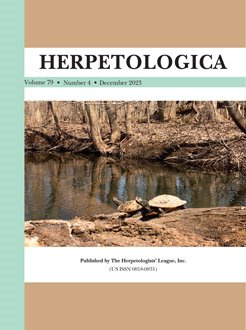The geographic isolation of conspecific populations can produce a diversification of signals through genetic drift, which may be reinforced by selection if populations (or sibling species) come into secondary contact. As conspicuous visual signals, bobbing displays of lizards have been described for numerous genera, and differences in display structure have been documented between some isolated conspecific populations. Although bobbing display structure has been detailed for several Galápagos Lava Lizard species (Microlophus sp.), intraspecific populations on different islands also exhibit various degrees of display structure divergence. In the present study, our goal was to determine if Microlophus bivittatus on San Cristóbal Island and a population on its adjacent islet of Isla Lobos possess differences in bobbing display structure. Interestingly, adult males on Isla Lobos exhibit gigantism compared to those on San Cristóbal, and the two populations have been isolated by the sea for several thousand years. We predicted that bobbing display speed would scale inversely with body size, such that displays would be detectably slower and longer in the supersized Isla Lobos males than those in the smaller San Cristóbal males. To test this prediction, we elicited displays from subjects by using a conspecific-mimicking robot. We measured two displays from 16 subjects in each population by using conventional unit-based variables as well as Fourier transform-based variables. After determining correlations among display variables, we tested for differences in uncorrelated display unit durations between Isla Lobos and San Cristóbal males. We then quantified within-subject, among-subject, and between-population variance for all variables by using nested ANOVAs and tested if variance differed between study populations at any level. Next, we used principal component analysis to create a small number of normally distributed variables (i.e., the principal components) from our original variables. These principal components then were used as inputs for discriminant function analysis to classify displays to populations. Comparisons of display unit durations supported our prediction only for the initial bob in displays, which was longer in Isla Lobos males than in San Cristóbal males. Nevertheless, when we considered multiple variables collectively, discriminant function analyses classified displays to the correct population at a level significantly greater than chance in all four unit-based analyses and three of four discrete Fourier transform-based analyses. Finally, supported by data on sexual size dimorphism and genetic differences between pairs of M. bivittatus populations (FST), our results indicate that divergence in bobbing display structure can occur relatively quickly if populations are sufficiently isolated.
How to translate text using browser tools
29 December 2023
They Might be Giants: Divergence in Display Structure between Two Island Populations of Galápagos Lava Lizards (Microlophus bivittatus)
Joseph M. Macedonia,
David L. Clark,
Morgan R. Fonley,
John W. Rowe,
Emma E. Neyer,
Emilio J. Mancero,
Carlos A. Valle
ACCESS THE FULL ARTICLE

Herpetologica
Vol. 79 • No. 4
December 2023
Vol. 79 • No. 4
December 2023
Discrete Fourier transform (DFT)
Discriminant function analysis (DFA)
Lizard displays
population divergence
PRINCIPAL COMPONENTS ANALYSIS (PCA)
Sexual dimorphism index (SDI)
Sexual Size Dimorphism (SSD)




